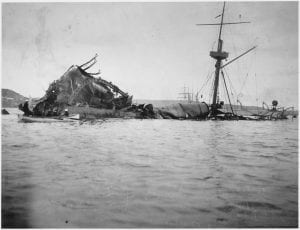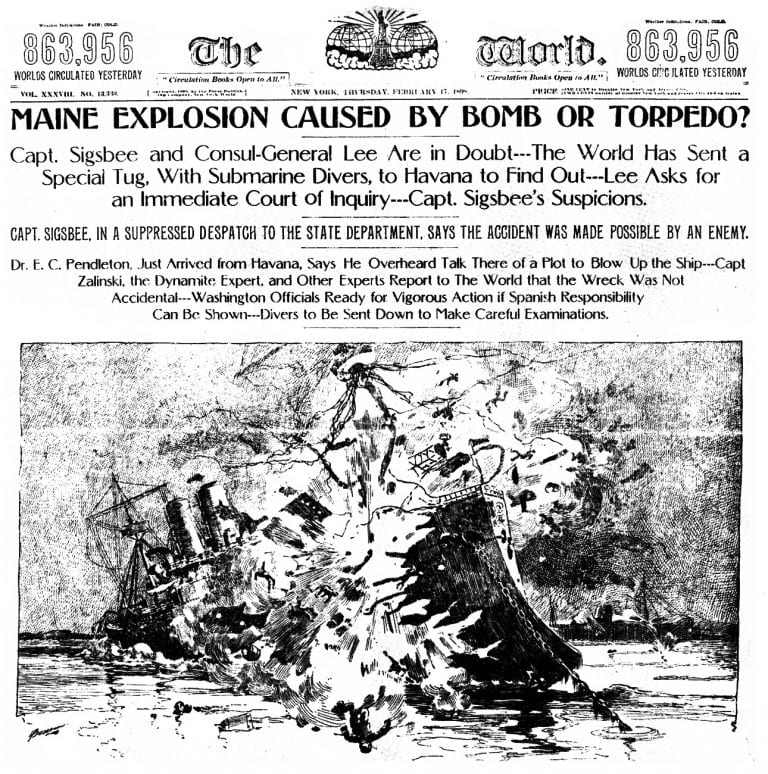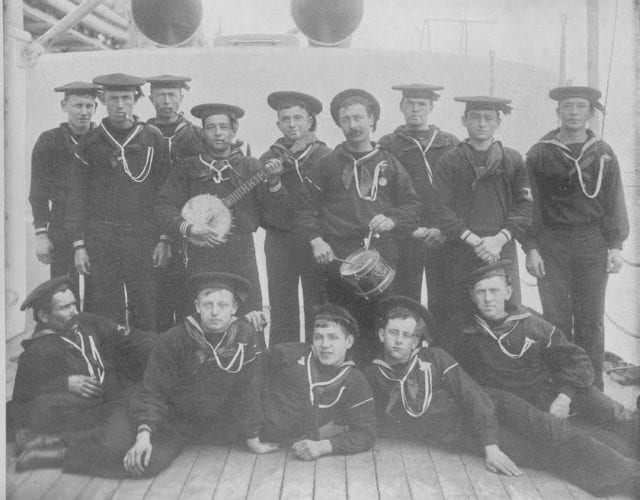U.S. Secretary of State John Hay called the Spanish-American War of 1898 a “splendid little war.” Superficially, the description seemed apt. After the battleship Maine mysteriously exploded in Havana Harbor — an incident then blamed on Spain — America went to war, our citizens urged to free Cuba from Spanish rule as well as avenge the Maine. Largely a naval war, an American squadron under Commodore George Dewey destroyed the Spanish squadron at Manila; likewise, the U.S. Navy crushed Spain’s Caribbean squadron off Cuba’s port of Santiago. In each engagement, the United States suffered only one fatality. Things went tougher for American troops in Cuba, where malaria and yellow fever proved as daunting as Spanish bullets. But American schoolchildren would thereafter thrill to tales of Teddy Roosevelt and his “Rough Riders,” and of the famed charge up San Juan Hill. Defeated on land and sea, Spain sued for peace. The war lasted less than four months; our fighting forces distinguished themselves with valor; and the United States, acquiring territory from Puerto Rico to the Philippines, emerged as a “world power.”
However, behind victory’s fervor lay deceptions, and principles of the Founding Fathers were discarded, portending future misery for Americans.
Cuba: Background to a Battleground
In the late 19th century, citizens were increasingly alarmed that monopolistic New York banking interests — represented by such names as Morgan, Rockefeller, Harriman, Carnegie, and Rothschild — were gaining a stranglehold on our economy. This helped inspire the 1891 establishment of the Populist Party, a grassroots movement of dissatisfied voters who perceived increasingly fewer differences between the Democratic and Republican parties, many of whose bosses were beholden to the bankers.
The Wall Street cabal realized that to thwart populism, it would be expedient to remove attention from themselves by inflaming Americans with hatred of another enemy. The enemy chosen was Spain, over the issue of Cuba. The reasons for this choice were as complex as they were sinister.
Spain was Europe’s leading colonial power in the 16th and 17th centuries, occupying much of North and South America. Through treaties and local revolutions, Spain lost much of this territory by the 19th century, but still retained a few possessions — notably Cuba, the world’s wealthiest colony and largest sugar producer by the 1820s.
Also in the late 19th century, a violent revolutionary movement hobbled Cuba’s prosperity. Most Americans considered this an internal Spanish affair. They had always viewed the purpose of our military as self-defense; furthermore, intervening in Cuba would have violated our neutrality laws. Transforming these attitudes required manipulation of public opinion.
Yellow Journalism
Thomas Jefferson said in 1807:
Nothing can now be believed which is seen in a newspaper. Truth itself becomes suspicious by being put into that polluted vehicle. The real extent of this state of misinformation is known only to those who are in situations to confront facts within their knowledge with the lies of the day.
Regrettably, Jefferson’s sentiments were little heeded in the 1890s. And a new media rogue had arrived — William Randolph Hearst, whose name became synonymous with “Yellow (dishonest) Journalism.” In 1895, the wealthy Hearst purchased the New York Journaland battled Joseph Pulitzer’s New York World to achieve the nation’s highest circulation. Hearst won, learning that in journalism, lies can become “truths” for the right price. But he and Pulitzer shared a common goal: war with Spain over Cuba.
Americans were told Cuba’s rebels were like our Revolutionary War soldiers — men yearning for self-government. While genuine patriots were among the Cuban insurgents, their leader, Máximo Gómez, was a Dominican-born revolutionary who could be compared to Fidel Castro, not George Washington.
Gómez avoided confronting Spanish troops, whom he could not hope to defeat. Instead he launched terrorism. Attempting to expel the Spanish economically, he set ablaze millions of sugar cane acres, making the island a virtual torch. Cubans who refused to support him were hanged from trees or hacked to death with machetes as “traitors.” Gómez’s men descended at night, setting small towns on fire after looting them. They stole all available cattle and horses, and at harvest seized farmers’ crops — much like the bandits in the films The Seven Samurai and The Magnificent Seven. Gómez also seized the farmers’ sons, forcing them into his ranks. Within his army, he was feared as ruthless and dictatorial, meting out the death penalty by machete to soldiers without due process.
As a result, rural Cubans fled to fortified towns. But there was little work for them, and with Gómez torching all crops he couldn’t steal, famine began in Cuba. Hearst’s Journal and Pulitzer’s World reported none of this — except the starvation, which they blamed on the Spaniards, who were trying their best to feed the population under devastating conditions.
Hearst and Pulitzer both claimed the problem was Cuba’s Spanish governor, General Valeriano Weyler, ordering “reconcentration” of citizenry into fortified towns. The accusation had a grain of truth. Weyler was sent to Cuba because the leniency of his predecessor, Arsenio Martinez Campos, had emboldened the revolutionaries. Since Gómez refused to fight in the open, Weyler decided to turn the tables — cut him off from his source of food and recruits. Weyler discovered that many Cubans still outside the fortified towns were Gómez sympathizers, acting as suppliers or spies. Weyler ordered them into the towns. This compounded the famine, but didn’t start it.
The Yellow Press called him “Butcher Weyler,” endlessly inventing atrocities, such as Spaniards roasting Catholic priests. On October 6, 1896, Hearst’s Journal carried this headline: “CUBANS FED TO SHARKS. Cries Heard at Night — They are Taken Outside the Harbor, and the Silent Ferryman Comes Back Alone.” Pulitzer’s World raved: “RAIDED A HOSPITAL — More than Forty Sick and Wounded Cubans Butchered.” But no hospital even existed in the region the World described.
Hearst discovered that tales of atrocities against women struck a special chord with readers. In December 1896 his Journal blared: “BUTCHERED 300 CUBAN WOMEN — Defenseless Prisoners Shot Down by Spanish Soldiers.” Americans were regaled with stories of Cuban “Amazon women” fighting the Spanish with Rambo-like ferocity. The New York Sun carried this headline in October 1896: “SHE SHOT SEVENTEEN SPANIARDS … She did not Retire Before the Attack of the Regulars, But Picked Them Off, Man by Man.”
Newspapers could not reproduce photographs then, so drawings were used. This enabled Hearst to “authenticate” stories with artists’ fabrications. He hired noted painter Frederic Remington. After Remington arrived in Havana in 1897, a famous exchange occurred. Reportedly, he cabled Hearst: “Everything is quiet. There is no trouble. There will be no war. I wish to return.” Hearst replied: “Please remain. You furnish the pictures and I’ll furnish the war.” Although Hearst denied this exchange took place, the words embody the reality.
Perhaps Remington’s most infamous illustration was a naked girl surrounded by three smirking Spanish ruffians, under Hearst’s Journal headline: “REFINED YOUNG WOMEN STRIPPED AND SEARCHED BY BRUTAL SPANIARDS WHILE UNDER OUR FLAG.” In reality, a Cuban woman, who had aided the revolutionaries, was searched by a Spanish matron, in privacy. Remington had not witnessed the event.
Hearst’s reporters rarely ventured outside Havana’s bars. Some never even traveled beyond Florida, where they forwarded tales spun by Cuban émigrés sympathetic to the revolutionaries. And some stories Hearst invented himself in New York.
Reporters telling the truth were few. One was the New York Herald’s George Bronson Rea, who got information first-hand by riding with the rebels for nine months. He summarized his experiences in his book Facts and Fakes About Cuba.
Although Rea favored Cuban independence, he proved that tales of Spanish oppression — beyond singular acts of revenge and counter-revenge one might expect in any war — were fabricated. He wrote: “I lived in Cuba for five years previous to the insurrection, and spent the best part of my time in the country, and I must say that if the Cubans were oppressed, I failed to discover in what manner.”
Rea demonstrated that the Yellow Press grossly exaggerated the number of rebels, invented battles from thin air, knew little of Cuban geography, and eventually claimed the insurgents had captured more towns than existed. At the lunacy’s height, Pulitzer’s World said the rebels possessed a navy and had conquered Havana.
Congress Moves Toward War
Unfortunately, the Yellow Press drowned voices of men like Rea. This impacted not only public opinion, but members of Congress, many having no other information sources about Cuba.
After the Journal’s fake “strip-searching women” piece, Congressman Amos Cummings introduced an angry resolution in response. Deceived by tales of “Americans starving in Cuba,” Congress appropriated $50,000 for their relief, but U.S. consuls in Cuba were hard-pressed finding “starving Americans” to dispense the money to. The belligerently pro-war Senator John T. Morgan, chairman of the Senate Foreign Relations Committee, quoted extensively from a report in Hearst’s Journal; Morgan’s successor as chairman, John Sherman, also relied on the Journal, calling it “one of the great journals of the country.”
After President McKinley appointed Sherman secretary of state, the latter wrote to the Spanish government, condemning General Weyler’s forcefulness, and urging “conduct of the war in a manner responsive to the precepts of ordinary humanity.” However, Sherman’s brother was Civil War General William T. Sherman, whose “war is hell” tactics made him abominable to Southerners. This irony was not lost on the Spanish foreign minister, whose reply reminded the secretary of “the expedition of General Sherman, that illustrious and respected general, through Georgia and South Carolina.”
According to Ferdinand Lundberg in his classic America’s Sixty Families, President William McKinley was beholden to the Rockefellers and Standard Oil. While governor of Ohio, McKinley went bankrupt, and was secretly bailed out by a syndicate headed by Rockefeller frontman Mark Hanna, who had known John D. since they were high-school classmates. Hanna became McKinley’s political manager. Many considered him the real White House boss; critics called the president “McHanna.” J. P. Morgan was another McKinley backer. Chicago’s Chronicle of April 14, 1898, commented: “The Rothschilds and the Morgans control the White House.”
As American cries for war grew, Spain sought to avoid it. General Weyler was recalled; the “reconcentration” policy was to be substantially reformed; and Cuba was offered semi-autonomy, similar to Canada’s relationship with Britain. Had McKinley and his controllers genuinely wanted peace, this should have placated them. Instead, the battleship Maine was dispatched to Cuba.
Tragedy in Havana Harbor
The Maine’s sinking remains the most enduring mystery of the Spanish-American War. One of McKinley’s riskiest appointments was Teddy Roosevelt, as assistant secretary of the Navy. Roosevelt incessantly pushed for a shooting war. Among his characteristic quotes: “McKinley is bent on peace, I fear.” One afternoon in February 1898, Roosevelt exploited the absence of Navy Secretary John Long to put the Navy on a war footing; he cabled Commodore Dewey in Hong Kong to prepare to attack Manila — even though war had not begun. When Secretary Long learned of this, he didn’t revoke the order, but said of Roosevelt, “the very devil seemed to possess him yesterday afternoon.”
On January 24, 1898, the inflammatory decision to send the Maine to Cuba was made at a White House meeting — of which no minutes were kept. Although the Spanish were advised that a warship would eventually visit, they were not expecting the Maine when it sailed into Havana January 25. This was unknown to the ship’s commander, Captain Charles Sigsbee, who wrote: “It became known to me afterward that the Maine had not been expected, even by the United States Consul General.”
With potential war looming, by what “oversight” did Washington fail to notify both Spanish and American officials in Havana of the battleship’s arrival? However, if anyone hoped shooting would erupt in the harbor, leading to war, they were disappointed. The Spanish, courteously if coolly, welcomed the Maine and permitted her to dock.
William Randolph Hearst now pushed the war buttons harder. He had paid bribes to have the private correspondence of Spanish Ambassador Enrique Dupey de Lôme spied upon. In a private letter to a friend, the ambassador called McKinley “weak and catering to the rabble,” “a low politician” who desired to “stand well with the jingos of his party.” In violation of diplomatic immunity, the letter was stolen and reprinted in Hearst’s Journal under the headline “THE WORST INSULT TO THE UNITED STATES IN ITS HISTORY.”
In reality, the leader of Cuba’s insurgents, Máximo Gómez, had paid far worse insults to America, lambasting George Washington, claiming McKinley and Congress were “in the employ of Spain,” and boasting that his men could lay waste to Florida in under a week. But Americans were not permitted to hear these words — only those of Dupey de Lôme, who resigned in embarrassment. The Spanish government apologized, but Hearst and other “Yellow Journals” had driven anti-Spanish feelings to fever pitch.
 Two days later in Havana Harbor, a massive nighttime explosion tore apart the Maine. The horror was unimaginable. Of 355 crew members, 266 perished; only 16 survivors escaped uninjured. The day after the incident, Hearst’s Journal already published artistic renderings of how it was supposedly done — torpedoes, placed under the ship, connected to the shore by electric wires. A Naval Court of Inquiry convened. After hearing testimony from witnesses and divers, it concluded that a submerged mine sank the Maine. However, it fixed no responsibility for the deed.
Two days later in Havana Harbor, a massive nighttime explosion tore apart the Maine. The horror was unimaginable. Of 355 crew members, 266 perished; only 16 survivors escaped uninjured. The day after the incident, Hearst’s Journal already published artistic renderings of how it was supposedly done — torpedoes, placed under the ship, connected to the shore by electric wires. A Naval Court of Inquiry convened. After hearing testimony from witnesses and divers, it concluded that a submerged mine sank the Maine. However, it fixed no responsibility for the deed.
But the Yellow Press had no reservations. Hearst’s Journal called it an act of “Spanish treachery.” As war cries intensified, a slogan was proclaimed: “Remember the Maine and to hell with Spain!” This was probably intended to arouse the desire for vengeance in the same manner that “Remember the Alamo!” inspired Sam Houston’s troops at the 1836 battle of San Jacinto. There was a glaring difference, however: The Mexican army undeniably slaughtered the Alamo’s defenders, but no proof implicated Spain in the Maine tragedy.
Spanish sailors risked their lives rescuing Maine survivors, who were cared for by Spanish doctors and nurses. The Spanish had no motive to provoke America, and desperately tried to avoid war. Spain still had mostly wooden warships, many in disrepair, which could not match the firepower of America’s increasingly steel navy. Admiral Pascual Cervera, who commanded Spain’s Atlantic squadron, warned his government of “our lack of everything that is necessary for a naval war, such as supplies, ammunition, coal, provisions, etc. We have nothing at all.” Furthermore, land war against American troops would be difficult in Cuba — less than 100 miles from the United States, but over 4,000 miles from Spain.
Continued on next page…



